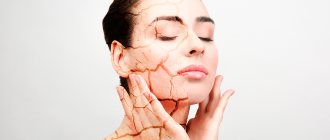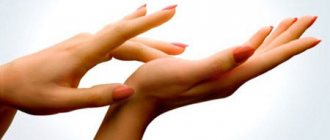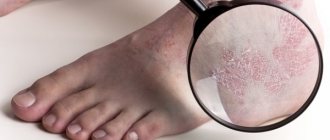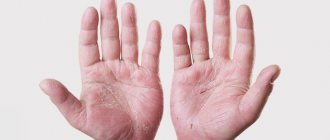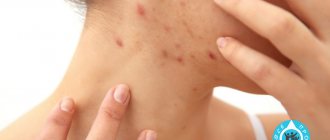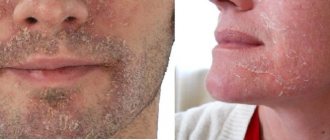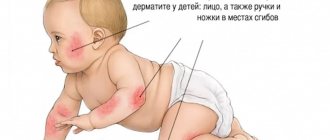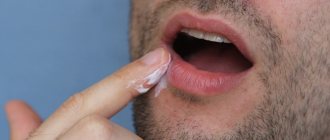Why do my palms peel?
Hands are one of those parts of the body that are more susceptible to negative external factors than others. It is natural for the skin to renew on them within a month, when the upper layer of the epidermis is replaced almost imperceptibly. If this becomes obvious, then there is definitely a problem in the body.
Symptoms
Skin peeling is manifested by several simple signs - it bursts or cracks, after which pieces of the epidermis appear on the surface, which peel off on their own or can be torn off. Such symptoms affect the fingers as a whole, the surface between them and their pads, the palm itself and its back side.
- peeling,
- burning and itching
- redness,
- rash,
- pain.
There are many reasons why palms and fingers peel and peel. It all depends on the individual, his skin and occupation. One of the main ones is an allergy to:
- cold,
- caring cosmetics – creams, ointments, soaps, etc.,
- food consumed,
- medicines,
- dishwashing detergent, especially if used frequently without gloves.
Another reason that the skin peels is the lack of proper hand care, including insufficiently deep moisturizing. This is especially true for those who have naturally dry skin. From a lack of vitamins, peeling of the epidermis is also often observed. With a deficiency of microelements, the elasticity of the skin decreases, which can cause cracks.
- prolonged exposure to the sun,
- dry air during the heating season or hot period of the year,
- the habit of constantly scratching your palms, which causes infection in the tissues,
- contacts with cement, dust, earth and other construction work.
A separate reason for peeling skin is a fungus. In this case, the manifestation of symptoms along the edges of the palms is especially characteristic. If the skin on the palms and other parts of the hands peels off, this may indicate some other diseases, such as:
- eczema,
- dermatitis,
- psoriasis,
- lichen planus,
- scabies (the skin peels off on the palms and between the fingers).
In this case, not only does the skin peel off, but also itching, redness and a rash appear. Changing cosmetics will not help here. Treatment is carried out after tests and can only be prescribed by a doctor. In addition to skin pathologies, the reason that the skin peels off is also diseases of the internal organs, parasitic, infectious, etc.:
- lupus erythematosus,
- parakeratosis, hyperkeratosis,
- syphilis,
- staphylococcal infections,
- scarlet fever (fingertips peel off),
- helminthic infestation,
- dehydration (skin peels, hair becomes dry),
- stress and neurological disorders,
- pathological processes in the pancreas,
- hormonal imbalance,
- reduced immunity.
The skin on the palm of one hand is peeling
The reasons why the skin peels off on the palm of one hand are the same as in the case of both hands. Although more often this phenomenon is observed in the event of contact with this hand of some kind of irritant. This is how an allergic reaction to detergent, cosmetics, food, sun or dry air manifests itself. Skin diseases can also be the cause of peeling palms.
The skin is bursting
A more serious problem is skin popping. It may be more painful. Among the external reasons for this phenomenon are:
- exposure to frost,
- aggressive household chemicals,
- unsuitable cosmetics,
- contact with solvents, paints and other compounds used during repairs.
There are a number of diseases that lead to the skin on the palms or arms in general bursting and peeling off:
- eczema,
- avitaminosis,
- fungal infections,
- psoriasis,
- dermatosis,
- metabolic disease,
- hormonal imbalances,
- heredity,
- taking antibiotics,
- inflammation in the body.
The skin on the child’s hands is peeling
In young children, peeling skin on the palms of the hands is often a consequence of vitamin deficiency, reduced immunity, or hormonal imbalance. For children, this condition can be very dangerous, so you should immediately consult a doctor. Preschool children have a habit of scratching their palms, which also leads to peeling palms. When peeling is combined with a rash and redness on the face, a child may be diagnosed with dermatitis.
Peeling of the skin on the palms is a very unpleasant phenomenon. It is often accompanied by itching and itching (in case of an allergic reaction to any chemical). The real cause of peeling skin can only be identified by a dermatologist after a series of tests and tests. Therefore, it is necessary to identify the problem as early as possible and contact a specialist.
All these factors affect the skin of the hands from the outside, causing a lot of unpleasant sensations. They are temporary and can be treated more easily than diseases caused by internal causes, which include:
- lack of vitamins A, E and B (manifested in peeling of the fingers, as well as between them),
- a consequence of long-term use of strong medications, including antibiotics,
- allergic reactions to any food product,
- genetic diseases,
- diseases of eczema or psoriasis.
This is not a complete list of reasons that can cause the skin of your palms and fingers to peel and crack. Only a dermatologist will provide more reliable information.
Why do my child’s palms and fingers peel?
The most common causes of peeling skin between the fingers and on the palms of a child are: lack of vitamins or fungus. In preschool age, children often neglect the rules of personal hygiene and, as a result, fungal microorganisms settle on the skin (especially between the fingers), causing itching and flaking.
In this case, only a specialist will help, since it is necessary to first determine the type of fungus, and only then prescribe an effective treatment against it. Self-medication is inappropriate here: we are talking about a child.
If the peeling of the skin between the fingers of a child is caused by a lack of vitamins and minerals, then it is enough to drink the course norm of multivitamins and the disease will be eradicated. But again, only a dermatologist can determine this. Therefore, you should not take risks and self-medicate. If a child has peeling skin on the palms of the hands and between the fingers, then it is necessary to seek qualified help.
Symptoms and types
Physiological peeling occurs constantly. It is usually unnoticeable. In pathological processes it becomes more pronounced. Depending on the size of the scales, peeling can be of the following types:
| Type of peeling | Peculiarities |
| Pityriasis | The scales are very small - more like flour. Typically, a similar problem occurs with rubrophytosis (fungal disease), lichen versicolor |
| Lamellar | The scales are larger than in the previous case. This symptom is characteristic of psoriasis. The scales are loose and easy to remove |
| Large-lamellar | The tissues are torn away in large layers. This is often a sign of erythroderma (a group of skin diseases). Dead skin particles stick tightly and are quite difficult to remove. |
The scales also vary in color. If they have a silvery or whitish tint, then this is characteristic of psoriasis, yellowish - for seborrheic dermatitis, dark - for ichthyosis. In some cases (a complication of psoriasis), the keratinized particles become saturated with exudate, causing a crust to form.
During peeling, other symptoms appear:
- itching;
- redness;
- blisters that burst;
- ulcers;
- spots.
Other causes of peeling
The reasons why the skin on the palms and fingers peels are varied, as are the diseases that cause these symptoms:
- Avitaminosis. Epidermal tissue damage occurs when there is a deficiency of vitamins A and C.
- Allergies to chemical detergents, latex products and other cosmetics. In response to irritation, the top layer on the hands peels and cracks.
- Contact dermatitis is a disease of chemical industry workers and anyone who has direct contact with household chemicals, latex gloves (cleaners, housekeepers and all women who clean the house using chemicals).
- Fungal infections are the most common dermatological disease. Girls (dishwashers, saleswomen in meat departments), male construction workers, workers in hot shops and chemical plants often suffer. It appears as weeping lesions, the surface of which is covered with bubbles, spots, and a whitish coating. The epidermis in them peels off and cracks.
- Eczema. There are many varieties, manifesting in different areas with the same symptoms. During an exacerbation, blisters and cracks appear, the skin of the affected areas itches and burns. Scratching leads to secondary infection.
- Psoriasis. The disease is known to be incurable. The appearance of plaques, scales and crusts on the hands and between the fingers is characteristic. The skin becomes rough and causes severe itching.
Oil wraps against cracks and itching on hands
You can get rid of redness and dry skin on your hands by using oil wraps. This procedure helps to enrich the underlying layers of the epidermis with nutrients.
Natural vegetable oils containing the necessary vitamins, minerals and enzymes are used for wrapping. Thanks to the influence of biologically active substances, blood circulation improves, metabolic processes are activated, and the elasticity of the dermis increases.
The most effective oils for wrapping:
- grapefruit (saturates cells with oxygen, stimulates blood circulation, smoothes out unevenness);
- geranium (increases skin tone, refreshes);
- orange (eliminates dryness and heals microdamages, suitable for sensitive skin);
- peach (moisturizes aging and dry skin);
- lemon (restores smoothness and elasticity);
- cinnamon (accelerates regeneration, improves the appearance of the epidermis in old age);
- lavender (has anti-inflammatory and healing effects).
The wrap mixture consists of base olive oil and a few drops of active essential oil. Sometimes olive oil is replaced with honey. A thin layer of the mixture is applied to thoroughly cleansed skin, which is covered with plastic film on top.
This creates something like a “greenhouse” effect. After 20-30 minutes, the mixture is washed off with warm water. To obtain a sustainable result, the procedure must be repeated 10-15 times.
Other causes of peeling
There are various negative factors that lead to disruption of the regeneration process of the epidermis and disruption of its integrity. During the natural process of skin renewal within a month, its top layer is completely replaced, and dead cells are almost imperceptibly removed from the surface of the epidermis.
Violation of the integrity of the upper layer of skin indicates pathological processes occurring in the body or the influence of negative factors.
The main reasons why the epidermis on the palms peels off:
- Insufficient hydration of the skin of the hands.
- Incorrectly selected cosmetic products.
- Prolonged exposure to sunlight.
- Dry air during the hot season or heating season.
- The bad habit of scratching your palms, which leads to the penetration of infections into the tissues.
- Allergic reactions caused by the negative effects of various chemicals, including detergents, hygiene products, cosmetics and medicines. In this case, a dermatologist most often diagnoses “contact dermatitis.”
- Skin diseases (eczema, psoriasis, dermatitis).
- Regular use of antibacterial soap leads to the fact that the skin loses its natural protection, and therefore becomes more susceptible to damage by various pathogenic bacteria and fungi.
- Secondary infections that occur when pathogenic microorganisms penetrate through microcracks in the epidermis.
- Lack of vitamins A, E, D, C, B in the body, which are directly involved in the processes of epidermal regeneration.
- Impaired drinking balance, leading to dehydration.
- Peeling of a child's palms is often caused by hormonal imbalance or a weakening of the child's immune system. It is also often observed when the baby’s skin is hypersensitive.
Diagnostics
It is difficult to identify exactly the reasons why the skin on both palms is peeling off on your own, because some tests are needed. During a visual examination, the doctor notes other symptoms, such as cracks, pain, redness or itching. He also determines the places where these signs are noted, if they are not only on the hands.
Only an experienced dermatologist will be able to determine the exact reason that the skin of the palms is peeling off. At the same time, sometimes a simple visual examination is not enough, so the specialist prescribes various studies of the patient’s health status. Thanks to the tests, the dermatologist will also identify a fungal infection of the skin, which is almost impossible to get rid of using simple methods.
Treatment
A certain therapy is prescribed by a doctor after diagnosing the disease. It may include medications and a number of care products, including traditional recipes. It can be especially difficult to get rid of fungal infections, but after identifying its type, this is quite possible with the correct selection of ointment.
Medication
The prescription of drugs is determined by the reason why the skin is peeling. In case of fungal infection, treatment is carried out using such means as:
- Nizoral,
- Ketoconazole,
- Exoderil,
- Fluconazole,
- Lamisil,
- Diflucan.
Therapy may not be very quick and may take a long time, up to several months. If the cause is an allergen, then you need to limit contact with it. To enhance the effect, it is necessary to take antihistamines, for example, Suprastin or Zyrtec. In addition to them, sorbents are often used that remove toxins from the body. When treating more severe diseases, such as eczema or psoriasis, the doctor himself determines the therapy. It includes:
- corticosteroid drugs – Advantan, Lokoid,
- anti-inflammatory medications - Elokom, Bepanten, Fenistil.
Self-medication is unacceptable here, as is the case with syphilis, lupus erythematosus, scarlet fever, scabies and other diseases that cause peeling. If the problem is a lack of vitamins, then you should take a multivitamin complex and additionally eat more fresh vegetables and fruits.
- Bepanten,
- Panthenol,
- Radevit,
- Neutrogenia.
Folk remedies
Traditional medicine recipes are also effective in combating peeling hands. Although it is better to use them as an adjuvant to the main therapy against a specific disease prescribed by a doctor. If the skin peeling is not caused by serious pathologies, then you can use the following folk recipes:
- Celandine ointment. To prepare it, add 1 cup of vegetable oil to the leaves of the plant. Then you need to boil this mixture, add 20 g of wax to it and keep it on the fire until it is completely dissolved. Apply the resulting composition to the damaged areas 2 times a day.
- Gelatin. Baths are made from this product. To do this, pour 1 teaspoon of gelatin into 1 glass of water. The mixture is boiled for 40 minutes, then allowed to stand for a while. You need to place your hands in the warm mass and hold it until it cools.
- Honey with oatmeal. A mask is made based on them. To do this, take 1 tablespoon of each ingredient, mix and leave for a couple of minutes. Leave this mask on the skin of your hands for about half an hour, then wash it off with warm water and lubricate the skin with a rich cream.
Cosmetics
Proper regular care is very important for hand health. Cosmetics in the form of creams, ointments, lotions and other types help to carry it out. Preparations with the following components will be effective for the health and beauty of the skin:
- hyaluronic acid,
- linoleic and linolenic acids,
- hexahydric alcohol sorbitol,
- collagen,
- glycerin.
These components help provide hydration to the epidermis, stimulate cell renewal, increase protective qualities and add elasticity. Moisturizers based on olive oil, jojoba oil, grape seed and apricot are also very useful. Any fatty ointment with these components has a positive effect.
Spring vitamin deficiency is identified as a separate disease. For treatment, a course of vitamin complexes and the consumption of fresh vegetables, fruits and dairy products are prescribed. Allergy treatment is carried out with Bepanten, Elocom, Fenistil, the course is supplemented with folk remedies and avoidance of foods such as chocolate, honey, carbonated drinks and others.
When treating contact dermatitis, you should remove all aggressive chemicals, use moisturizers, emollients, ointments and creams, use antibiotics and antiviral medications. Dermatitis and eczema are treated with anti-inflammatory and antiallergic drugs. It is necessary to find out the cause of the exacerbation and follow a diet during such periods.
Fungal diseases are diagnosed after examining the scales under a microscope. Drugs for the treatment of candidiasis: Ketocanazole, Candide, Clotremizan, Fluconazole and others. They are taken for a long time (up to 1 month) until the symptoms disappear. Antifungal ointments are used externally for another week after recovery for prevention.
For mycosis, in addition to pharmaceutical medications, treatment with folk remedies is used in the form of infusions, decoctions, herbal baths (celandine, lavender extract, chamomile), various oils (almond, flaxseed, sage oil). A potato mask moisturizes well and makes your hands soft and tender (raw grated potatoes are applied to the damaged areas, a glove is put on your hand for two hours).
Hand masks are prepared from fermented milk products (sour cream or kefir is applied to the dry surfaces of the palms and covered with a napkin). It is good to wipe the outer side of the brush dehydrated in the sun with cucumber juice. Use an oatmeal scrub to remove the stratum corneum.
How to get rid of peeling palms
It is even better to use a mixture of olive oil and liquid honey for lubrication. But if you are allergic to a bee product, exclude it from the mask
Grated potatoes or soaked oatmeal in water are also effective home remedies. This mass is applied daily for 15–20 minutes to problem areas until a lasting improvement occurs. Regularly treat your skin with freshly squeezed aloe or cucumber juice.
Also interesting to read: home baths for weight loss.
Therapy
In any case, when the skin on the palms peels off, it requires careful care. After each hand washing, shower or bath, gently blot your palms with a soft towel, avoiding vigorous rubbing. By drying your hands in this way, a person prevents irritation of the epidermis.
The complex of therapy to eliminate peeling skin of the palms must include the following measures:
- Using moisturizing soap that does not dry out the epidermis.
- Transition to a balanced diet, rich not only in vegetables and fruits, but also in products containing vitamins A, E, B, C and microelements (zinc, selenium), fatty acids that have a beneficial effect on the condition and regeneration of the skin. This diet should contain a sufficient amount of eggs, butter, fatty fish, whole grain products (bread, cereal), and also include liver and veal. Herbal products such as peaches, melons, dill, celery, and asparagus have a very beneficial effect on the skin of the hands.
- In case of severe pathology, it is necessary to take a course of complex medications containing the entire set of vitamins and microelements a person needs.
- When the skin of the palms peels off, we can immediately talk about poor drinking balance, which leads to severe drying of the epidermis. An adult should drink at least 1.5 liters of clean water daily. During the hot season, this amount can almost double.
- When contact dermatitis appears due to the action of some chemicals, it is necessary to exclude skin contact with the suspected source of skin pathology. Dermatitis should be treated immediately as it is accompanied by severe itching. As a result of scratching the epidermis, various pathogenic microorganisms penetrate into the tissue, provoking the occurrence of a secondary infection that requires long-term and expensive treatment.
- If a fungal infection of the epidermis is detected, the dermatologist prescribes external medications, such as Nizoral, Mifungar, Fluconazole, Ketoconazole, Lamisil, Diflucan, Exoderil creams.
- For persistent itching, antihistamines (Loratidine, Suprastin, Diazolin) are prescribed.
- When allergens get inside the body, take sobrents that promote their rapid elimination (activated or white carbon, Enterosgel).
- Steroid drugs (Prednisolone) are used to treat various skin diseases (dermatitis, eczema, psoriasis). Anti-inflammatory drugs (Elokol, Bepanten, Fenistil) and corticosteroid ointments (Lokoid, Advantan) are applied topically to the skin.
Causes of dry hand skin
Wrinkling, peeling, permanent condition of the skin of the upper extremities - many people are familiar with this situation. These symptoms are a signal from the body that it is necessary to start taking care of your hands. Insufficient care, vitamin deficiency and stress have a bad effect on the condition of the epidermis. However, the causes of dry hand skin are not only external. This condition may be due to other factors:
- Diseases of the gastrointestinal tract. With a lack of vitamins and microelements, the functioning of the digestive system is disrupted, which immediately affects the condition of the epidermis.
- Diabetes. Increased sugar provokes dry skin.
- Iron-deficiency anemia. The disease causes dry and itchy skin, which begins to crack and hurt.
- Fungal infections. If your feet are affected by a fungus, then it is more likely that the peeling of your hands is also caused by it.
- Allergy. Caused by anything from household chemicals to wearing rings. A dermatologist will identify the allergen after tests.
Home Remedies
The following home remedies are used to eliminate peeling palms:
- Lubricate the skin daily with olive or sea buckthorn oil (2 times a day).
- Hand baths with decoctions of medicinal herbs (calendula, chamomile, nettle) and a few drops of vitamins A and E, taken every other day, will make the skin smooth and healthy in just a few sessions.
- Apply a mixture of finely grated raw potatoes and oatmeal swollen in water (1:1) to the palms. The procedure lasts 15-20 minutes. It is carried out daily until a noticeable improvement occurs.
- Regularly lubricating your palms with freshly squeezed aloe or cucumber juice promotes rapid regeneration of the epidermis.
- Using paraffin hand masks 1-2 times a week will quickly eliminate peeling of the epidermis, make it moisturized and smoothed. This procedure is very popular in beauty salons, but it can also be performed at home. To do this, melt cosmetic paraffin in a steam bath, add a few drops of vitamin A or E to it and dip your palms into it several times. After a fairly thick layer of paraffin has hardened, warm mittens and plastic bags are put on your hands. The procedure lasts 20 minutes. After this, the paraffin is removed, hands are rinsed with warm water and lubricated with moisturizer.
How to properly care for dry skin
So, we have found out the main causes of dry facial skin, now we will understand the rules of care and treatment. The main thing that needs to be done is to regularly cleanse, nourish and moisturize the skin, and also protect it from the effects of sunlight, wind and frost.
Cleansing
You should cleanse your face twice a day - in the morning and evening. For cleansing, you need to select products such as milk or cream intended for removing makeup.
It is also good to use hydrophilic oil, cleansing gel for sensitive skin.
In the morning, to cleanse dry facial skin, you can apply vegetable oil, liquid cream, or milk.
Washing with cold or hot water is very harmful. You need to make it a rule: in winter, wash your face with water at room temperature, and in summer, cool water. Before washing, you can apply fermented milk products.
Toning
After morning cleansing, the skin requires toning. A tonic lotion without alcohol is perfect for this. Apply a small amount to a cotton swab and wipe the face well, avoiding the area around the eyes.
tonic lotion, which includes natural vitamins
For toning, you can also apply creams that contain collagen and elastin. Rose water has proven itself well.
It is recommended to buy cleansing and toning products from the same manufacturer.
Cosmetologists recommend applying tonic masks two to three times a week. The toning procedure with masks should be alternated with the nutrition procedure. The right toning mask will not only tone dry skin, but also protect and tighten it.
How to moisturize your skin
Before applying makeup, moisturize your face with day cream
You need to choose a cream with a certain composition - it should contain: hyaluronic acid, milk proteins, sorbitol, antioxidants, vitamins, extracts from natural products.
After applying the product, it should be removed with a dry cloth or cotton swab after 15-20 minutes.
Skin nutrition
Before going to bed, after cleansing, the face is lubricated with a night cream that will nourish it. It should be a greasy product specially made for dry skin.
You need to choose cosmetics that contain vegetable oils, ceramides, fatty acids, aloe extracts, marine plants, whey, vitamins A, E.
Important! Night cream is applied thickly to the face one to two hours before bedtime. 10 minutes after spreading the cosmetic product, you need to blot it with a dry cloth - during this time the skin will already absorb all the nourishing ingredients
In the summer, a rich cream before bed can be replaced by wiping your face with ice cubes made from herbal decoctions.
Periodically, the skin should be nourished with masks.
Protection
The protective effect will be provided by a daytime low-fat or semi-oily cream. There are also special protective creams on sale that are designed for enhanced protection against external aggressive factors. They will need to be applied before going outside and removed after returning home.
It is especially important to protect your face with special products in winter, when it is undesirable to use moisturizers. They are applied under the powder, thus creating a thin protective film.
Preventive measures: what should be done?
Regular preventive measures can help prevent skin problems. It consists of good hand care, which includes:
- Dry your hands thoroughly after washing,
- refusal of antibacterial soap in favor of a soft gel for sensitive hand skin,
- drink up to 2 liters of fluid daily to prevent dehydration,
- in summer, use sunscreen,
- in cold weather, always wear mittens or gloves,
- maintain proper nutrition so that the diet is rich in vitamins,
- use rubber gloves when doing housework,
- use hypoallergenic cosmetics,
- Lubricate your skin with moisturizing creams daily.
To avoid unpleasant symptoms on the skin of the palms and fingers (itching, peeling, cracks), you need to: moisturize them daily, exfoliate dead cells, wash your hands with cosmetics containing glycerin, take baths with herbal infusions, give preference to hypoallergenic cosmetics. It is necessary to include the following components in the diet: greens, nuts, cereals, cereals, vegetable oil, and take complexes of vitamins and minerals.
Remember! Hands, our main helpers, need constant care, perhaps even more than the face and other parts of the body.
Hands should be protected from temperature changes. In cold weather, be sure to wear warm gloves or mittens, avoid contact with the ground and cement during construction work, and if necessary, wear protective gloves. Dishwashing detergents should be gentle, do not forget rubber gloves (if you are not allergic to them!).
Severely irritate the skin of the hands and feet, mechanical injuries lead to cracks, as well as burns and hypothermia. If dryness on the inside of your palms appears as a result of dehydration, you should increase the amount of water you drink to cope with it.
Compresses for cracks and itching on hands
Homemade compresses are one of the effective methods of caring for the epidermis of hands prone to dryness. If your hands have cracks and damage, a compress containing oil-based vitamin A will be effective. It is characterized by healing, nourishing properties, and also eliminates irritation.
Before using the compress, you need to steam the skin in a bath with chamomile or St. John's wort.
To carry out the procedure, a piece of cotton fabric is soaked in a medicinal agent and applied to the hands. The top of the compress is covered with film or paraffin paper and left for 20 to 40 minutes.
Gelatin compress increases the elasticity of the dermis and restores its healthy appearance. 3 tbsp. gelatin must be poured with water and wait until it is absorbed. Then the composition is heated, the fabric is soaked in it and applied to the hands. Keep the compress for 45-60 minutes, then wash it off with warm water.
